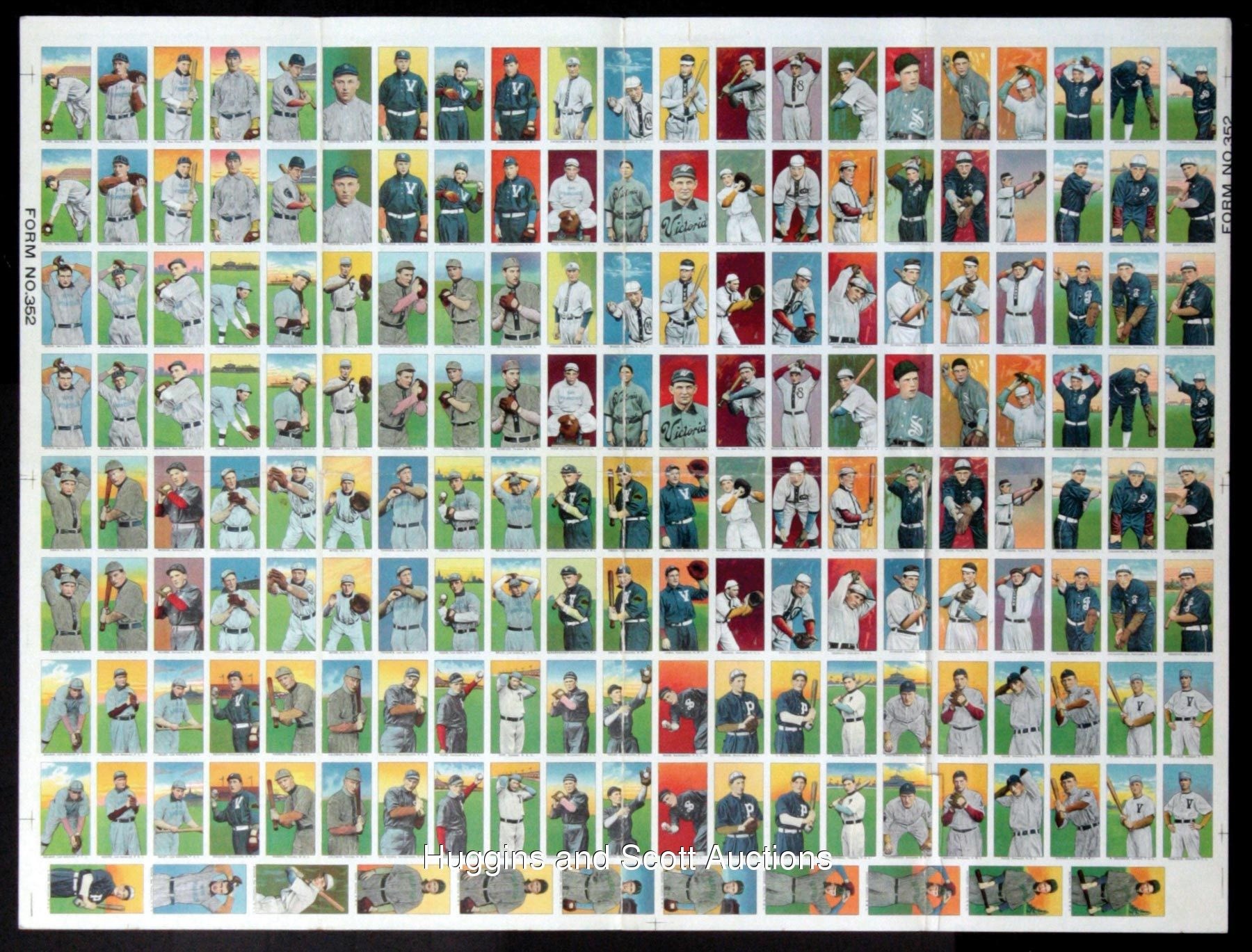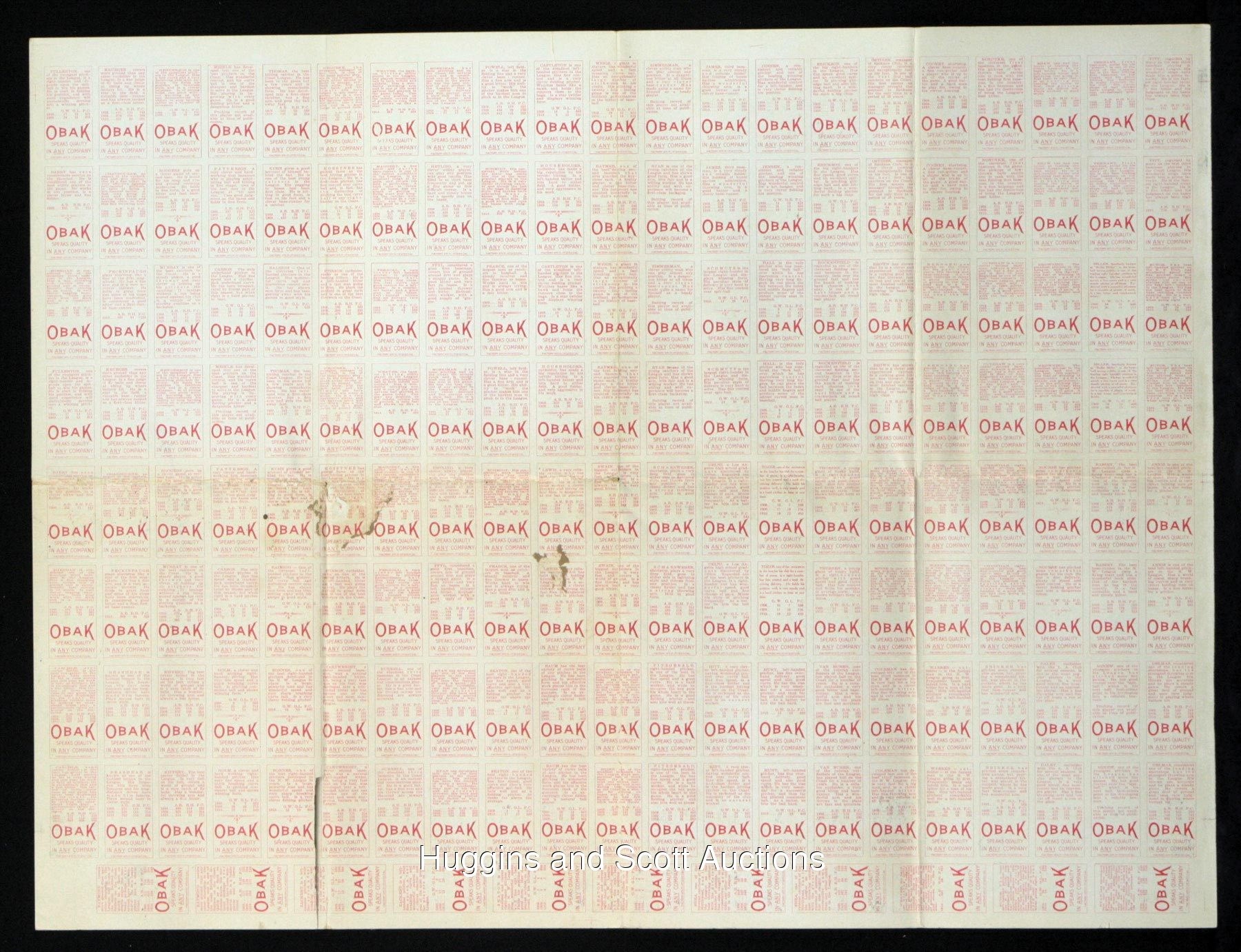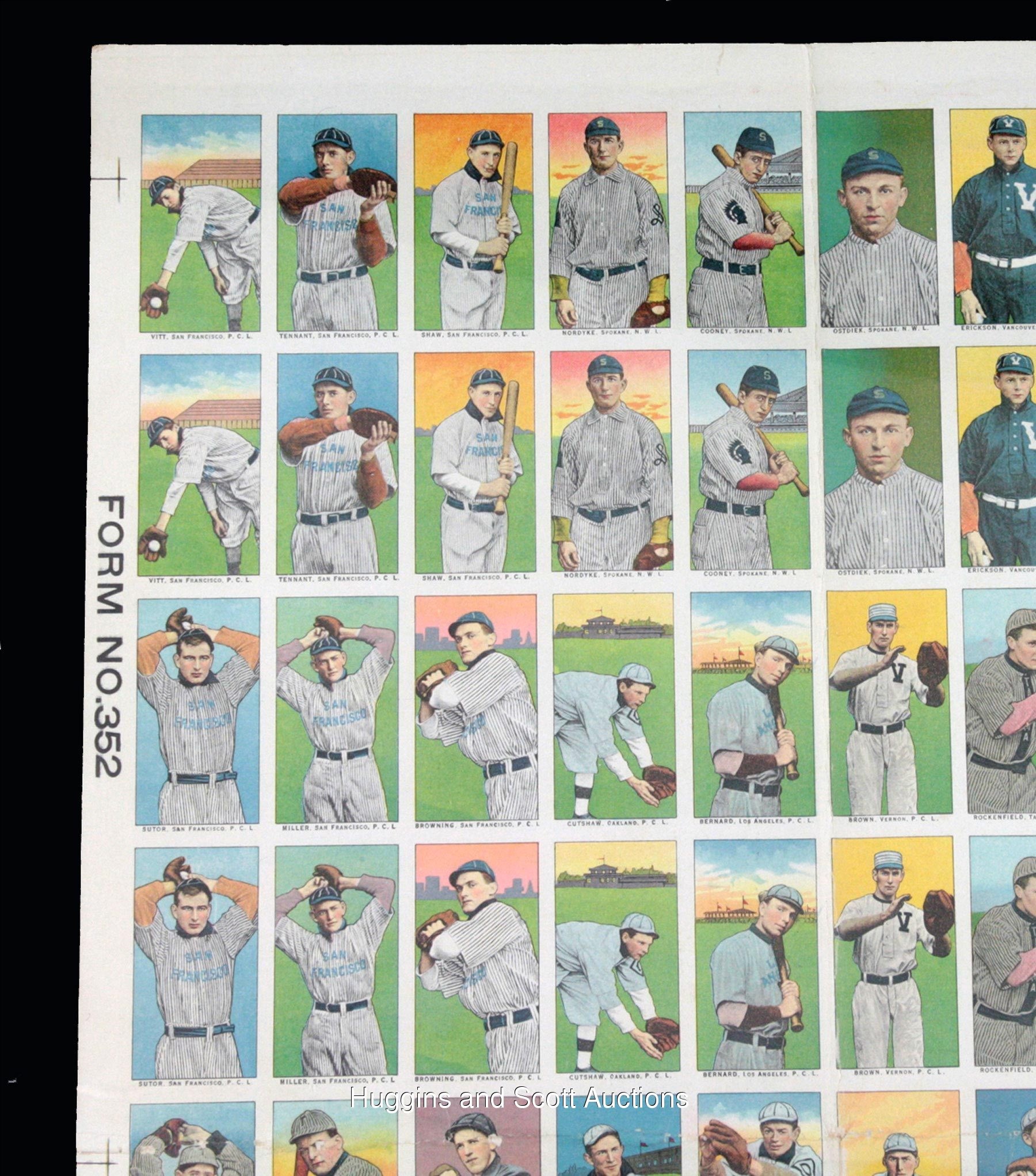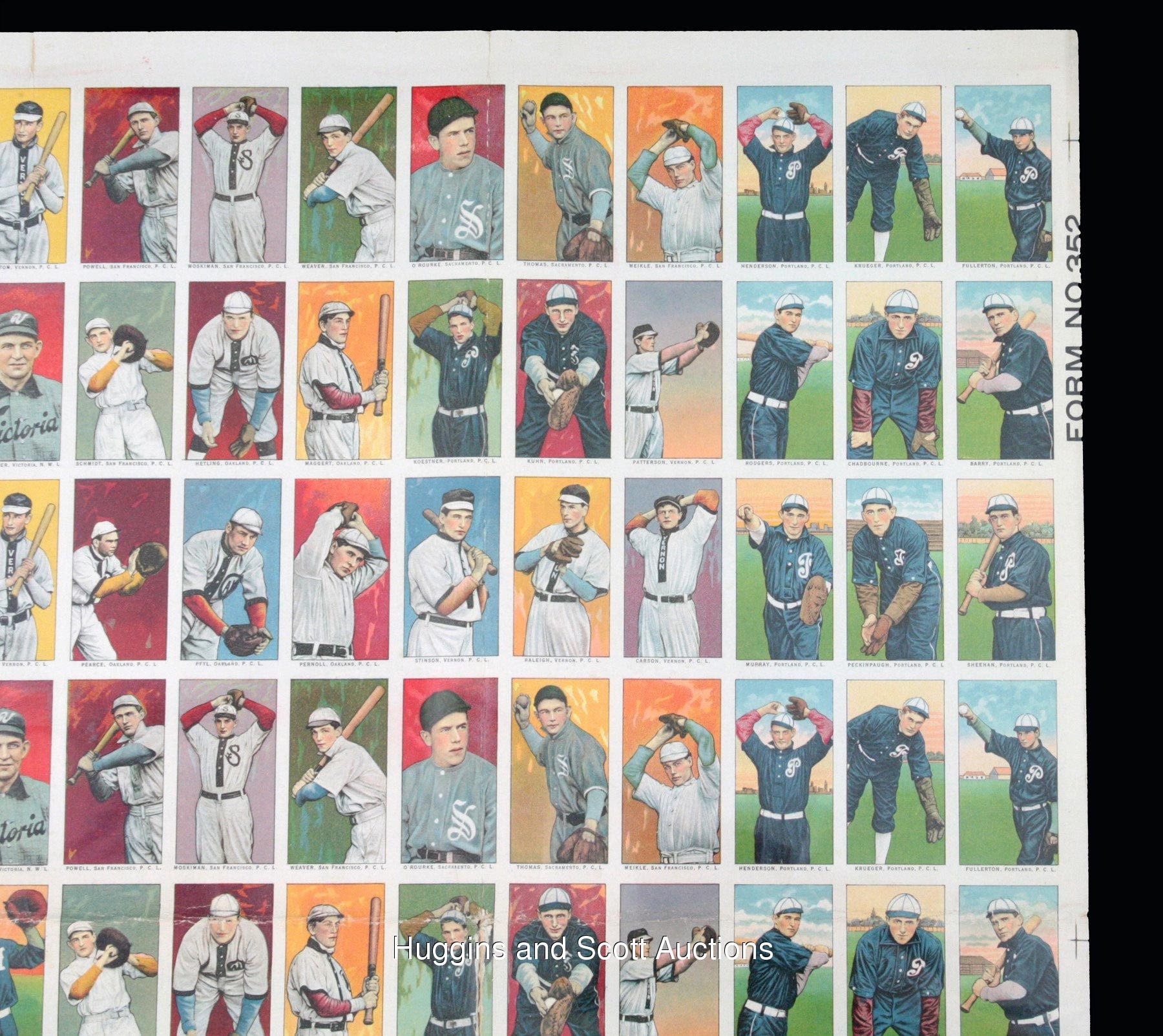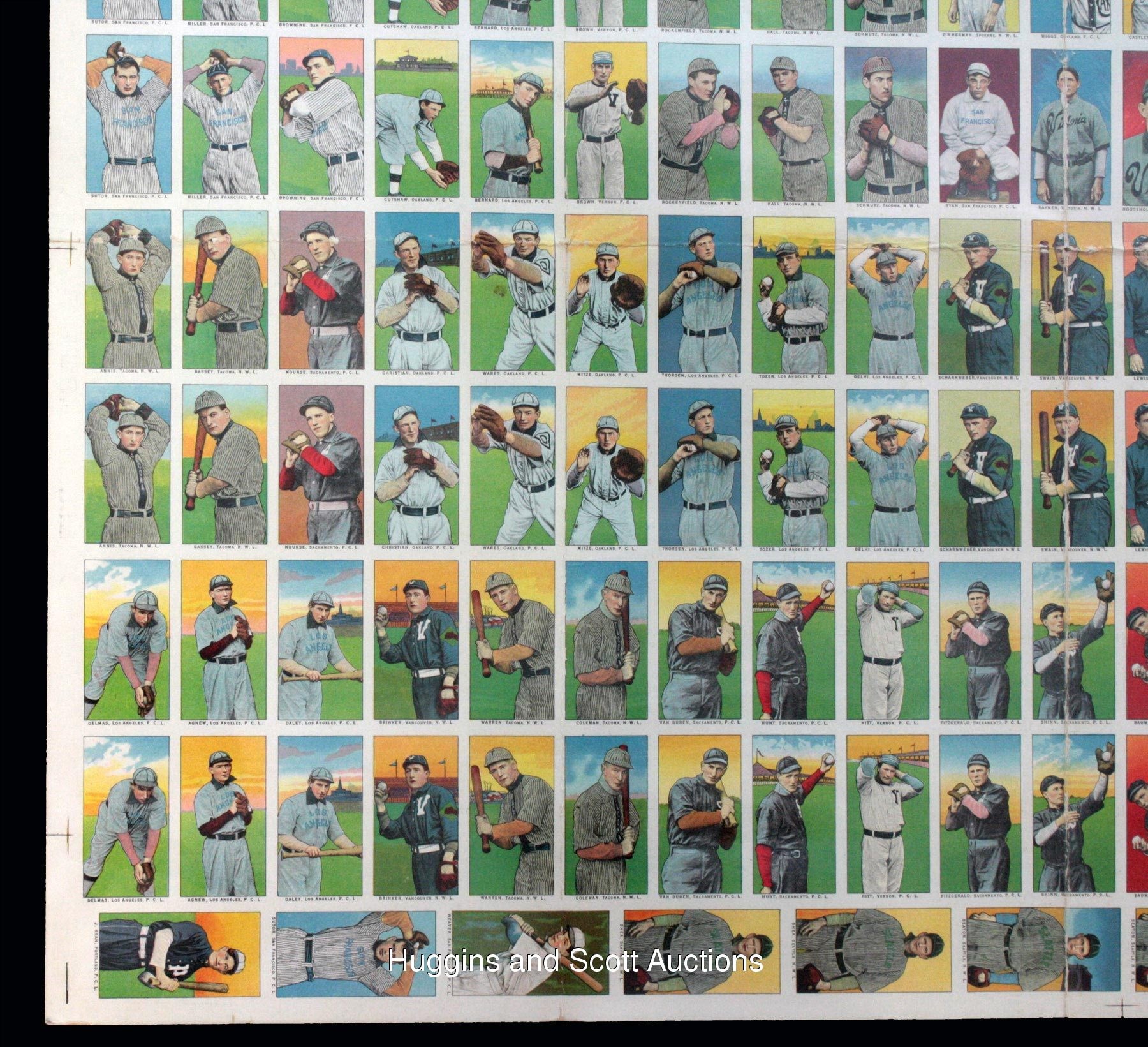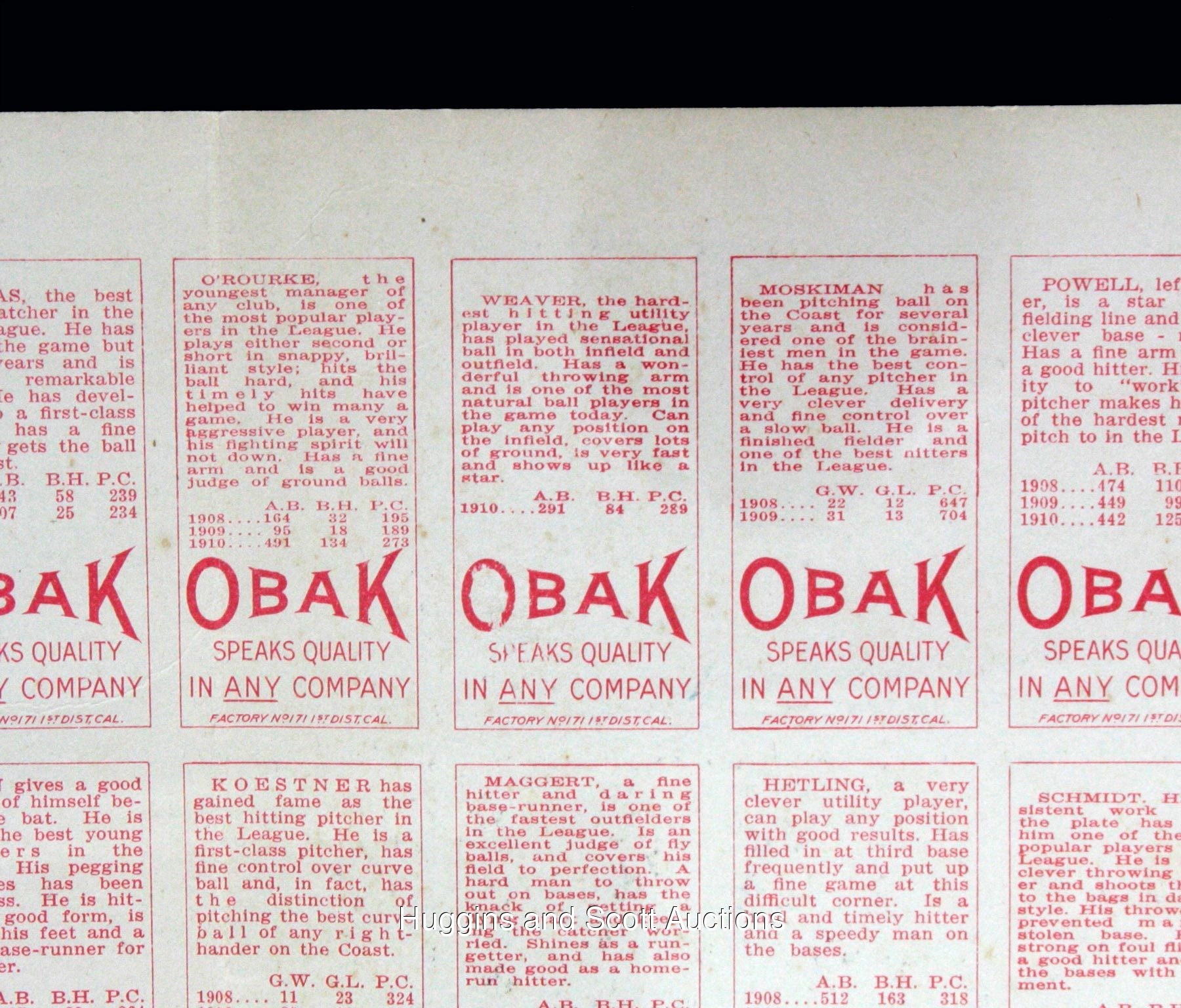Search
1911 T212 Obak Full Uncut Sheet of (179) Cards with (3) Buck Weaver
- Sold For: $18,800
- Year: 1911
- Auction: 2010 September
- Lot #: 2
- Auction Category: Prewar Baseball - T Tobacco Cards
With a challenging slate of games often approaching two hundred per season, the combatants of the early twentieth century Pacific Coast and Northwestern Leagues were some of the most colorful and hardworking personalities in the game. Capturing twelve teams and dozens of future major leaguers, the 1911 T212 Obak series featured western minor leaguers in what is often considered the most attractive baseball series issued during the tobacco card era. In April 2010, our Northern California-based consignor uncovered an incredible keepsake in his personal belongings. Three decades prior, a business associate gave our consignor several items from his father’s collection. A former employee of the Schmidt Lithography Company of San Francisco, these personal effects included advertising images, illustrations and a neatly folded sheet of baseball cards inserted into a manila 15x10 envelope. Measuring 31 x 23-1/2”, the offered 1911 T212 Obak full uncut sheet of (179) cards is likely unique and the largest baseball cigarette uncut sheet known in the hobby. While similar sheets (likely partial) of the 1909 series (76 cards) and 1910 edition (76 cards) have sold through competing auction houses, this (179) card galley overwhelms all others known. The interesting configuration includes (8) 21-card vertical rows and a single 11-card horizontal arrangement at the bottom of the sheet. Among the (88) different players, (85) players have two cards each, while a trio of players are displayed three times. Improbably, George “Buck” Weaver of 1919 "Black Sox" Scandal fame is one of those subjects depicted three times! Two of the Weavers have sustained either moderate creasing or a trace of reverse paper loss. Other prominent subjects include (2) Castleton and (2) Peckinpaugh. For a complete list of subjects, additional history and condition details, please visit our website. Player Selection: Top Row: (21 cards) with Vitt, Tennant, Shaw, Nordyke, Cooney, Ostdiek, Erickson, Jensen, James, Zimmerman, Wiggs, Castleton (first Mormon in big leagues), Powell, Moskiman, Weaver, O’ Rourke, Thomas, Meikle, Henderson, Krueger, Fullerton; Second Row: (21 cards) with Vitt, Tennant, Shaw, Nordyke, Cooney, Ostdiek, Erickson, Jensen, James, Ryan, Raymer, Householder, Schmidt, Hetling, Maggert, Koestner, Kuhn, Patterson, Rodgers, Chadbourne, Barry; Third Row: (21 cards) with Sutor, Miller, Browning, Cutshaw, Bernard, Brown, Rockenfield, Hall, Schmutz, Zimmerman, Wiggs, Castleton (first Mormon in big leagues), Pearce, Pfyl, Pernoll, Stinson, Raleigh, Carson, Murray, Peckinpaugh, Sheehan; Fourth Row: (21 cards) with Sutor, Miller, Browning, Cutshaw, Bernard, Brown, Rockenfield, Hall, Schmutz, Ryan, Raymer, Householder, Powell, Moskiman, Weaver, O’ Rourke, Thomas, Meikle, Henderson, Krueger, Fullerton; Fifth Row: (21 cards) with Annis, Bassey, Nourse, Christian, Wares, Mitze, Thorsen, Tozer, Delhi, Scharnweber, Swain, Lewis, Schmidt, Hetling, Maggert, Koestner, Kuhn, Patterson, Rodgers, Chadbourne, Barry; Sixth Row: (21 cards) with Annis, Bassey, Nourse, Christian, Wares, Mitze, Thorsen, Tozer, Delhi, Scharnweber, Swain, Lewis, Pearce, Pfyl, Pernoll, Stinson, Raleigh, Carson, Murray, Peckinpaugh, Sheehan; Seventh Row: (21 cards) with Delmas, Agnew, Daley, Brinker, Warren, Coleman, Van Buren, Hunt, Hitt, Fitzgerald, Shinn, Baum, Seaton (Portland), J. Ryan, Burrell, Cartwright, Bonner, Holm, Kippert, Brashear, Carlisle; Eighth Row: (21 cards) with Delmas, Agnew, Daley, Brinker, Warren, Coleman, Van Buren, Hunt, Hitt, Fitzgerald, Shinn, Baum, Seaton (Portland), J. Ryan, Burrell, Cartwright, Bonner, Holm, Kippert, Brashear, Carlisle; Bottom Row: (11 cards, horizontal) with J. Ryan, Sutor, Weaver, (2) Shea, (2) Seaton (Seattle), (2) Zackert, (2) Raymond; Overall Player Composition: (179 cards, 88 different) with (2) Agnew, (2) Annis, (2) Barry, (2) Bassey, (2) Baum, (2) Bernard, (2) Bonner, (2) Brashear, (2) Brinker, (2) Brown, (2) Browning, (2) Burrell, (2) Carlisle, (2) Carson, (2) Cartwright, (2) Castleton (first Mormon in big leagues), (2) Chadbourne, (2) Christian, (2) Coleman, (2) Cooney, (2) Cutshaw (for big league veteran), (2) Daley, (2) Delhi, (2) Delmas, (2) Erickson, (2) Fitzgerald, (2) Fullerton, (2) Hall, (2) Henderson, (2) Hetling, (2) Hitt, (2) Holm, (2) Householder, (2) Hunt, (2) James, (2) Jensen, (2) Kippert, (2) Koestner, (2) Krueger, (2) Kuhn, (2) Lewis, (2) Maggert, (2) Meikle, (2) Miller, (2) Mitze, (2) Moskiman, (2) Murray, (2) Nordyke, (2) Nourse, (2) O’Rourke, (2) Ostdiek, (2) Patterson, (2) Pearce, (2) Peckinpaugh (former major league star), (2) Pernoll, (2) Pfyl, (2) Powell, (2) Raleigh, (2) Raymer, (2) Raymond, (2) Rockenfield (was also in T206 set as Southern Leaguer), (2) Rodgers, (3) Ryan, (2) J. Ryan, (2) Scharnweber, (2) Schmidt, (2) Schmutz, (2) Seaton (Portland), (2) Seaton (Seattle), (2) Shaw, (2) Shea, (2) Sheehan, (2) Shinn, (2) Stinson, (3) Sutor, (2) Swain, (2) Tennant, (2) Thomas, (2) Thorsen, (2) Tozer, (2) Van Buren, (2) Vitt (former big league veteran), (2) Wares, (2) Warren, (3) Weaver (legendary big league star of Black Sox fame), (2) Wiggs, (2) Zackert, (2) Zimmerman; Condition of Sheet: This uncut sheet of (179) cards has endured the century in remarkable condition with blazing surface hues and detailed lithography. The only full uncut sheet from the 1910s known, this item was neatly folded and stored in a 15x10 manila envelope for several decades. Multiple horizontal and vertical creases along the middle edges of the perimeter span the entirety of the sheet, affecting more than half of the subjects in varying degrees of impact. Partial separation is found in two places along a five player strip including Koestner, Stinson, (2) Cartwright and Seaton (Seattle). Among key players, the Weaver on the bottom horizontal row has sustained moderate creasing. The back is remarkably clean with significant back damage affecting only five players. The Weaver along the top row concedes minimal paper loss—the other Weaver (fourth row) is problem free. Incidental age toning is found throughout. This sheet is absent of writing. Other stars including Castleton and Peckinpaugh have sustained only superficial creasing or wear. Excerpts about the Schmidt Lithography Company of San Francisco from the April 1930 California Journal of Development (Vol. XX, No. 4, California State Chamber of Commerce): “Max had less than twenty-five dollars when he boldly hung out a sign bearing the name of M. Schmidt & Co., from the modest building at 353 Clay Street. Ten dollars of his capital was used to pay the first month's rent. The sign was neatly lettered and proved a magnet that drew customers. Max was sure of himself, but not over-confident. It was a quality of self-assurance, coupled with the ability to make quick, correct decisions at critical moments, and to choose the right kind of assistants, that was ultimately to send him to the top of his chosen profession.” “The consistent quality of Schmidt labels, and other products as well, is assured by the fact that the company tests all materials used in its many processes.” “From a humble beginning, with only two hand presses with a capacity of 480 sheets, cap size, daily, the establishment has grown until today its press capacity alone is more than 300,000 impressions per day of a sheet approximately twelve times as large as the old hand press size, while the variety of its products has increased from letter heads and plain labels to include labels, cartons, cutouts, countercards, window trims, hangers, billboard posters, car cards, program covers, menus, show cards, and all forms of lithographed advertising.”
